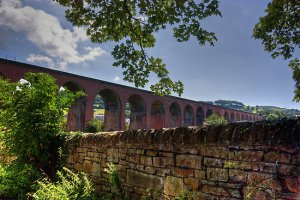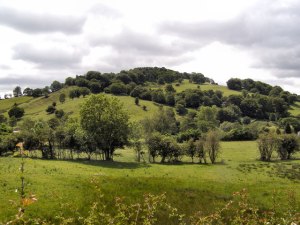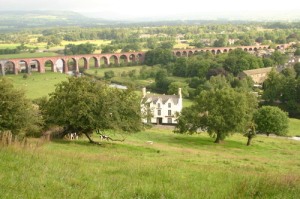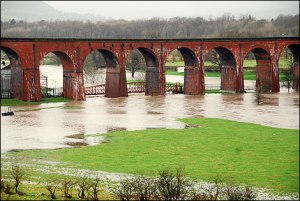Cutting dramatically through the breathtaking rural scenery of the Ribble Valley is a supreme example of Victorian era engineering at its very finest. But this seven million brick super structure is completely upstaged by the spell binding views in all directions, and as a heartbreaking consequence the dignified and noble Whalley Viaduct attracts very little attention.
For its time, this viaduct was ground breaking, totally ahead of the game. Had this audacious feat of railway engineering been built anywhere else, it might just attract a little bit more attention and affection towards itself, as its younger brother that spans the river Mersey thirty miles away in Stockport does, for example.
But this modest and majestic 49 arch viaduct stands strongly and proudly in quiet splendour, drowned out by an area of outstanding natural beauty that goes on in all directions and for as far as the eye can see. This was not a good place to build anything to be admired since nature had already raised the bar so highly with magnificent sweeping panoramas of Whalley Nab, Pendle Hill, the Forest of Bowland, Kemple End and on especially clear days, views as far reaching as Blackpool Tower to the west and Pen Y Ghent in North Yorkshire to the east. Facing straight ahead is the mesmerising Trough of Bowland and directly behind is the village and the delightful Whalley Nab – a hilly tree lined meadow so tall, pretty and dainty, you could be excused for believing it was a fictional painting. See pic below.
But enough about the scenery… Back to the Viaduct. The 605 metre long super structure known locally as Whalley Arches was built by the Blackburn and Bolton railway company, under the supervision of chief engineer Terrence Wolfe Flanagan. Building began in 1846 and was completed in 1850. The line opened on Saturday 22nd June 1850 and the 340 strong work force behind it enjoyed a celebratory party thrown in their honour, which included a ride across their very own arches in a brand new 15 coach train. The local population came along to witness the opening, and twelve men were armed with truncheons at Whalley station in a bid to keep the peace – such was the fervent enthusiasm to ride on one of the trains that “rode through the sky.”
It’s difficult to believe that a structure so gigantic and heavy has weathered the Lancashire climate for over one hundred and sixty years and still stands so solid and proud to this day. But then again, when the Victorians built things, they were built to last forever. The red bricked viaduct still carries hourly passenger trains from Clitheroe to Manchester and provides passing for goods trains from all over the north and Scotland.
The work of building the structure that was to remain the tallest and longest railway viaduct in Lancashire came as a huge boon for the tiny village of Whalley, three miles away from the nearest market town hamlet of Clitheroe. All seven million bricks that were used in the construction were made in Whalley, formed from clay taken from Hardle common.
The picture below shows the Arches coping with regular flooding as the river Calder swells onto farm land on the banks of the river. Hilariously, the council are fighting to win a legal battle to build houses on this land. What a hoot! Don’t say anything to them will you?
On a more serious note. Tragedy struck when the viaduct was close to completion. Three lives were lost on the 6th October 1849, when two of the arches collapsed during construction. Builders Johnny Forsythe, Thomas Keefe and Charles Harrison were killed. The arches that fell are numbers twelve and thirteen, counting from the Billington end of the structure. A period of heavy rain was blamed for the arches not setting properly when their timber supports were taken down.
So the next time you are nonchalantly ignoring the Whalley Arches as you drive alongside them on the A59, or as you walk carefree in the beautiful countryside all around them – or as you sit on a train that is quietly rumbling across them, take a moment to consider what an extraordinary structure you are just taking for granted!
After publishing this blog, I was told about an excellent video that has been produced by John Whipp, detailing the repairs to the arches in 2011.This is an excellent film which must have taken many months to film. Click here to open it, and thank you John Whipp for putting such a great film together.
CLICK HERE to read about Steve’s debut Novel, The Clitheroe Prime Minister




